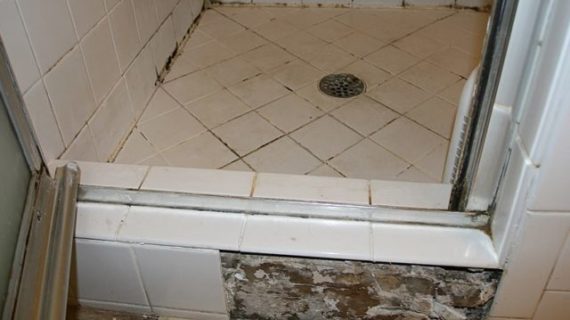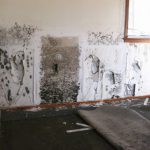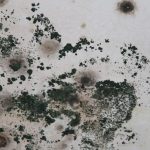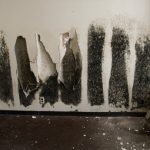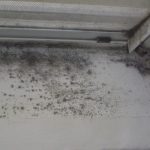Black mold likes to grow in the wet and damp area. Some areas such as basement, kitchen, and bathroom which are usually more humid than any other rooms in the house can be the perfect place for mold to grow.
This toxic mold will not only grow on the bathroom or kitchen walls but also infect the furnishings and fixtures in those rooms.
The shower is one of them. If you notice any dark scum coming out from the shower, you have right to worry since it can be a sign of black mold infestation.
Why does Black Mold Grow in My Shower?
As a device that releases drops of water, the shower is obviously wet and can be a perfect ground for black mold breeding.
Shower stall which seals in water can also collect moisture inside of its parts and in the result, causing the black mold to develop larger.
Another factor that causes black mold to grow in the shower is the layer of dirt and skin produced by body oils and soap scum whenever you use the shower.
The dirt and grime which are not cleaned properly provide the food source as well as the ground for the mold to live in.
How do I Know That Mold has Infected the Shower?
The presence of black mold and mold, in general, can be detected by your sense of smell. Black mold produces damp, strong, and unpleasant odors which are easy to notice.
If you smell such odors while using the shower but it seems difficult to find the cause. There is a possibility that the black mold has been growing inside your shower.
Black mold can also be recognized by its appearance. The mold that has developed in the shower may come out along with water when it is used to rinse the soap.
Be aware of gray or black small scum that you notice while taking a bath. The scum of black mold can be easily distinguished from natural foam or scum of soap.
Black Mold in Shower Health Risks

Most types of black mold which develop in a wet and moist surface are the primary cause of several allergic symptoms.
Those symptoms can lead to other serious health risks, including respiratory illness, feverish disease, contamination problems. Sometimes depression and death in some extreme cases.
Because it is used every day, a shower that has been infected by black mold carries a greater risk that can damage your health.
Black mold symptoms are most likely to damage the health of those who have undeveloped or low immune system. Particularly babies, children, and the elderly.
Several health risks below are closely associated with black mold exposure in the shower.
- Flu-like symptoms, including coughing, sneezing, sore throat, and fever,
- Respiratory problems, from a sinus infection and difficulty breathing to pneumonia, asthma attacks, and bronchitis.
- Allergic reactions which are related to skin problems, such as rash, hives, and dermatitis.
- Headaches, migraines, and hair loss.
- Weakened immune system that may result in several infections including ear infection or nosebleed in some cases.
- Exhaustion and chronic fatigue which can lead to some psychological disorders like depression.
- Mainly in infants and toddlers, black mold exposure is the primary cause of pulmonary hemosiderosis or pulmonary hemorrhage.
In other serious cases of black mold infestation, kidney failure is another health risk that everyone should be aware of. Those numerous health risks are the reasons for you to start taking black mold problem more seriously.
How to Prevent Black Mold in Shower
A simple way to prevent the growth of black mold on the flat surface or area is keeping the area as dry as possible.
However, it sounds impossible to apply the same rule to the shower. In that case, routine cleaning can do the work in preventing black mold in the shower.
Here are some basic tips you can use to prevent the growth of black mold in the shower.
- Clean your shower regularly using cloth, rag, or sponge, twice to three times a week.
- To maximize the cleanup, cleaning agents or anti-bacterial chemical substance is helpful, but make sure that the substance you use is made of safe materials and will not cause any allergic symptoms.
- After the cleaning, always wipe the shower dry to reduce leftover moisture as well as to minimize the excessive water drops.
- There is plastic insert available in the market that can help you prevent the mold growth in the shower. The shower’s plastic inserts are easy to be taken out whenever you need to clean the shower.
You can also prevent black mold from growing in the shower by paying more attention to the whole parts of the bathroom. One effective way in preventing black mold development and infestation is using anti-mold paint for the bathroom wall.
This type of paint contains a resistant substance that can stop the growth of black mold.
The shower is producing steam which is the major causes of black mold infestation. In this regard, anti-mold paint on the bathroom wall can do its job by holding the shower steam. Preventing it from infecting more largely to other areas in the bathroom.
How to Clean Black Mold in Shower
If black mold has infected your shower, you need to clean up right away. Some simple steps below will guide you to clean black mold in the shower.
- Before operating the removal process, prepare rubber gloves, clean cloth, sponge, cleaning brush, bleach, dish washing liquid, and detergent.
- Wear the protective equipment and take the shower apart into separate pieces.
- Wet the sponge with water and spread the washing liquid on it. Use the sponge to clean the black mold inside the shower. Make sure you don’t leave any residue.
- Dry the shower with a dry cloth.
- Spray the bleach solution onto the shower and wash it using cold water. Wait for about 10 minutes for the solution to work.
- For the final cleaning, use detergent with a small cleaning brush to reach the hidden parts of the shower in case there is any black mold left.
- Rinse the shower with cold water, let it dry, and fix the shower back to its place.
Considering health risks caused by black mold, having the information related to black mold infestation in the shower can save you from further hazards resulting from this toxic mold.
